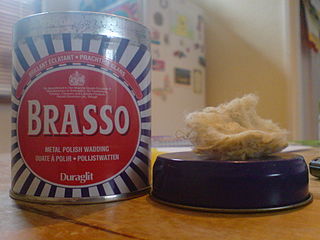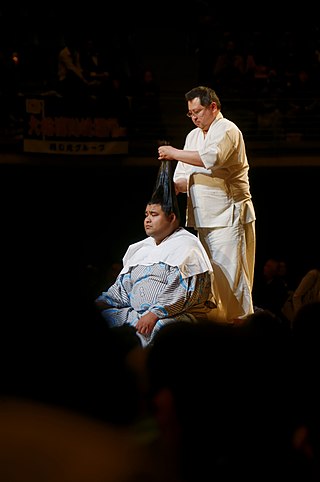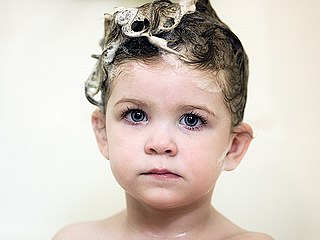
Beeswax is a natural wax produced by honey bees of the genus Apis. The wax is formed into scales by eight wax-producing glands in the abdominal segments of worker bees, which discard it in or at the hive. The hive workers collect and use it to form cells for honey storage and larval and pupal protection within the beehive. Chemically, beeswax consists mainly of esters of fatty acids and various long-chain alcohols.

Cosmetics are constituted mixtures of chemical compounds derived from either natural sources, or synthetically created ones. Cosmetics have various purposes. Those designed for personal care and skin care can be used to cleanse or protect the body or skin. Cosmetics designed to enhance or alter one's appearance (makeup) can be used to conceal blemishes, enhance one's natural features, add color to a person's face, or change the appearance of the face entirely to resemble a different person, creature or object. Due to the harsh ingredients in makeup products, individuals with acne-prone skin are more likely to suffer from breakouts. Cosmetics can also be designed to add fragrance to the body.

Petroleum jelly, petrolatum, white petrolatum, soft paraffin, or multi-hydrocarbon, CAS number 8009-03-8, is a semi-solid mixture of hydrocarbons, originally promoted as a topical ointment for its healing properties. Vaseline has been a well-known American brand of petroleum jelly since 1870.

Lip gloss is a cosmetic used primarily to give lips a glossy luster, and sometimes to add a subtle color. It is distributed as a fluid or a soft solid The product is available in ranges of opacity from translucent to solid and can have variously frosted, glittery, glossy, and metallic finishes.

Brylcreem is a British brand of hair styling products for men. The first Brylcreem product was a hair cream created in 1928 by County Chemicals at the Chemico Works in Bradford Street, Birmingham, England, and is the flagship product of the brand. The cream is an emulsion of water and mineral oil stabilised with beeswax. It is notable for the high shine it provides, which spawned the name of the product, stemming from "brilliantine" and "cream".

Brasso is a metal polish designed to remove tarnish from brass, copper, chrome and stainless steel. It is available either directly as a liquid or as an impregnated wadding pad.

Hair conditioner is a hair care cosmetic product used to improve the feel, texture, appearance and manageability of hair. Its main purpose is to reduce friction between strands of hair to allow smoother brushing or combing, which might otherwise cause damage to the scalp. Various other benefits are often advertised, such as hair repair, strengthening, or a reduction in split ends.

Hair gel is a hairstyling product that is used to harden hair into a particular hairstyle.

Hair mousse, also referred to as styling foam, is a hairstyling product to protect, control, and style hair. "Mousse" originates from a French term meaning foam. Hair mousse originated in France and was brought to the North American retail market by L'Oreal in the 1980s.

Lip balm or lip salve is a wax-like substance applied typically to the lips to moisturize and relieve chapped or dry lips, angular cheilitis, stomatitis, or cold sores. Lip balm often contains beeswax or carnauba wax, camphor, cetyl alcohol, lanolin, paraffin, and petrolatum, among other ingredients. Some varieties contain dyes, flavor, fragrance, phenol, salicylic acid, and sunscreen.

Moustache wax is a stiff pomade applied to a moustache as a grooming aid to hold the hairs in place, especially at the extremities. The required product strength is based on whisker length and the desired style. It can also have restorative properties, which become more important as the hair length increases. The wax is usually scented and sometimes pigmented with dyes; high end products utilize various combinations of iron oxide to create darker shades.

A tokoyama (床山) is a hairdresser employed by the Japan Sumo Association to cut and prepare sumo wrestlers' hair, which is done in the chonmage style. The Sumo Association ranks them according to experience and ability and only the most senior tokoyama are entitled to prepare the more ornate ōichō, or ginkgo leaf form of topknot, which sekitori-ranked wrestlers wear in their bouts and on other formal occasions. Tokoyama employ similar hairstyling techniques to those found in the construction of nihongami, and are expected to be on hand to fix the chonmage of sumo wrestlers during bouts.

Pomade is a greasy, waxy, or water-based substance that is used to style hair. It generally gives the user's hair a shiny, slick appearance. It lasts longer than most hair-care products, and often requires multiple washes for complete removal. The pomades of the 18th and 19th centuries consisted mainly of bear fat or lard. Lanolin, beeswax and petroleum jelly have been used extensively in modern pomades. The hold of pomades makes sculptured hairstyles such as the pompadour waves (hairstyle) possible.
A relaxer is a type of lotion or cream generally used by people with tight curls or very curly hair which makes hair easier to straighten by chemically "relaxing" the natural curls. The active agent is usually a strong alkali, although some formulations are based on ammonium thioglycolate or formaldehyde.
Anal bleaching is the process of lightening the color of the skin around the anus. It is done for cosmetic purposes, to make the color of the anus more uniform with the surrounding area. Some treatments are applied in an office or salon by a cosmetic technician and others are sold as cream that can be applied at home.

A thickening agent or thickener is a substance which can increase the viscosity of a liquid without substantially changing its other properties. Edible thickeners are commonly used to thicken sauces, soups, and puddings without altering their taste; thickeners are also used in paints, inks, explosives, and cosmetics.
Personal care products are consumer products which are applied on various external parts of the body such as skin, hair, nails, lips, external genital and anal areas, as well as teeth and mucous membrane of the oral cavity, in order to make them clean, protect them from harmful germs and keep them in good condition. They promote personal hygiene and overall health, well-being and appearance of those body parts. Toiletries form a narrower category of personal care products which are used for basic hygiene and cleanliness as a part of a daily routine. Cosmetic products, in contrast, are used for personal grooming and beautification. Pharmaceutical products are not considered personal care products.

Shampoo is a hair care product, typically in the form of a viscous liquid, that is used for cleaning hair. Less commonly, shampoo is available in solid bar format. Shampoo is used by applying it to wet hair, massaging the product into the scalp, and then rinsing it out. Some users may follow a shampooing with the use of hair conditioner.
Hairstyle products are used to change the texture and/or shape of hair.

Frizz is hair that does not align with the surrounding hair, but stands up or curls independently, creating a fuzzy or irregular texture. The three main causes of frizz are genetics, hair damage, and humidity. Frizzy hair can be seen as a positive or a negative trait depending on the current fashion and one's personal preference. Many hair products, such as gels, pomades, and hair waxes, are designed to reduce frizz.
















